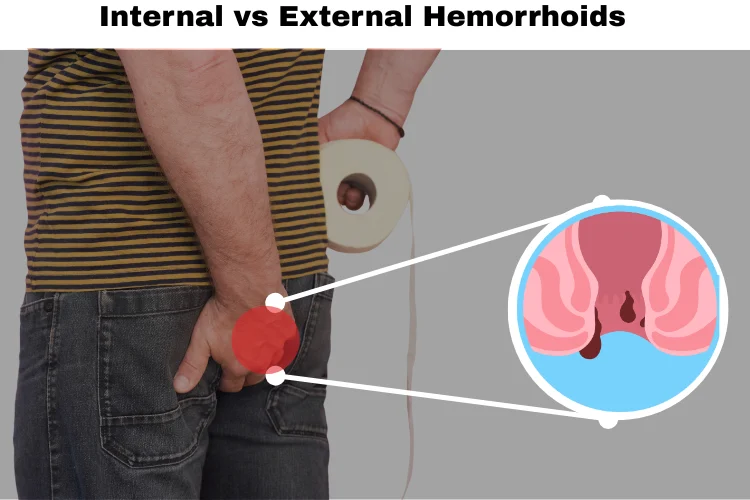Understanding Hemorrhoids
Hemorrhoids, or piles, are a prevalent health problem that impacts millions of individuals. Whether you are experiencing pain or discomfort while moving your bowels, knowing the main differences between internal vs external hemorrhoids is important for deciding on the appropriate treatment and enhancing your quality of life.
What Are Hemorrhoids?
Hemorrhoids are swollen blood vessels in and around the anus and rectum. They can be classified into two main types: internal hemorrhoids and external hemorrhoids, each with its own set of symptoms and treatment approaches.
What Are Internal Hemorrhoids?
Internal hemorrhoids are located within the rectum, superior to the dentate line (the boundary between the skin and mucous membrane). Internal hemorrhoids tend not to be painful but can cause bleeding on defecation. When they become severe, they can prolapse (protrude out of the anus) and be painful.
Symptoms of Internal Hemorrhoids:
- Painless bleeding (bright red blood on toilet paper)
- Feeling of incomplete bowel movement
- Prolapse or protrusion of the hemorrhoid (in advanced cases)
What Are External Hemorrhoids?
External hemorrhoids are located around the outside of the anus, beneath the skin. These hemorrhoids are typically more painful because they are closer to nerve endings. They can cause significant discomfort, especially during bowel movements.
Symptoms of External Hemorrhoids:
- Pain or discomfort during bowel movements
- Itching or irritation around the anus
- Swelling and inflammation around the anal area
- Possible blood clots (thrombosis), leading to increased pain
Key Differences Between Internal vs External Hemorrhoids
| Feature | Internal Hemorrhoids | External Hemorrhoids |
| Location | Inside the rectum | Outside the anus |
| Pain | Usually painless | Painful, especially during bowel movements |
| Bleeding | Common, usually painless | Rare, but can occur with thrombosis |
| Swelling | May prolapse or protrude | Swelling is common |
| Treatment | Less invasive treatments, such as creams and rubber band ligation | Requires creams, warm baths, or sometimes surgery for thrombosis |
How to Treat Internal Hemorrhoids?
Internal hemorrhoids are located within the rectum, on top of the dentate line (the zone separating the skin from the mucous membrane). Internal hemorrhoids usually don’t hurt but may bleed after a bowel movement. They can prolapse (fall out of the anus) and be painful if they’re in bad cases.
1. Dietary Changes
Boost the fiber intake to avoid constipation and facilitate bowel movements. Fruits, vegetables, whole grains, and lots of water may assist.
2. Over-the-Counter Treatments
Hydrocortisone or witch hazel creams, ointments, or suppositories can reduce inflammation and discomfort.
3. Rubber Band Ligation
For very large internal hemorrhoids, a rubber band is placed around the hemorrhoid to cut off its blood supply, making it shrink.
4. Sclerotherapy
A chemical solution is injected into the hemorrhoid that makes it shrink.
5. Surgical Options
Hemorrhoidectomy (surgical removal of the hemorrhoid) is very rare.
How to Treat External Hemorrhoids?
1. Warm Sitz Baths
Immersion in warm water for 10–15 minutes, 3–4 times a day, may minimize pain and swelling.
2. Cold Compress
A cold compress or an ice pack applied may decrease swelling and numb pain.
3. Topical Treatments
Use topical creams or wipes with over-the-counter hydrocortisone, witch hazel, or other gentle ingredients to calm pain and swelling.
4. Thrombectomy
If an external hemorrhoid is thrombosed (blood clot), a physician can do a minor procedure to drain the clot and treat pain.
5. Surgical Removal
Surgical removal is extremely rare and only needed when other treatments fail.
Prevention Tips for Hemorrhoids
To prevent both internal and external hemorrhoids, consider the following tips:
- Eat a high-fiber diet and stay hydrated
- Avoid straining during bowel movements
- Exercise regularly to promote healthy digestion
- Avoid prolonged sitting, especially on the toilet
When to See a Doctor
If your hemorrhoid symptoms continue despite home care, get worse, or are accompanied by severe pain and bleeding, see a doctor. Rubber band ligation, sclerotherapy, or hemorrhoidectomy can be required in medical treatments.
Conclusion: Treatment Options & Key Takeaways
Knowing the main differences between internal vs external hemorrhoids allows you to make more informed decisions regarding treatment. Whether through changes in diet, over-the-counter medications, or more serious medical interventions, there are numerous ways to treat and manage hemorrhoids effectively.
If your symptoms are not getting better or you develop complications, get medical guidance to get the optimal treatment for what you have.
Book your appointment and visit us today!
FAQs
1. Are external hemorrhoids more painful than internal hemorrhoids?
Yes, external hemorrhoids are often more painful because they are located closer to nerve endings.
2. Can external hemorrhoids be cured without surgery?
Yes, most external hemorrhoids can be cured with warm baths, topical ointments, and dietary changes.
3. How do I know if my hemorrhoids are internal or external?
Internal hemorrhoids are found within the rectum and typically do not hurt, whereas external hemorrhoids are found outside and tend to hurt more.
4. What do I do if I have internal and external hemorrhoids?
Treatments for both tend to be the same, except in serious cases, when a doctor must be consulted for treatment plans together.




